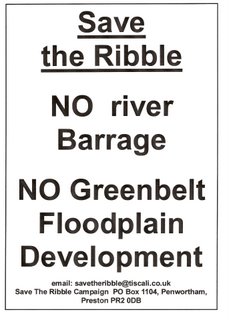RIVERWORKS, WHO STANDS TO GAIN: PROPERTY CONSULTANTS OR THE ENVIRONMENT?
Property Consultant, architect, and Riverworks supporter Tarquin Scott has presented his vision for the development of the River Ribble and Green Belt, and derides Save the Ribble Campaign’s concerns as “flawed” (Lancashire Evening Post, “River Quibble” 21/2/07).
Mr Scott’s article suggests that a key aim of Riverworks is to “conserve our environment”. Mr Scott’s arguments indicate that he has not read the Riverworks documents properly since these make it quite clear that the objective of Riverworks has nothing to do with protecting the environment and everything to do with “creat[ing] development opportunities on a regional scale”.
With a stated aim to “provide alternative development options to those emerging in the large city conurbations of Liverpool and Manchester….Riverworks is an urban concept on which a third city can be developed”. Riverworks
Furthermore, Mr Scott’s article suggests that he does not understand the full environmental impact of the proposals themselves.
In making a link between Riverworks and environmental benefits Mr Scott relies on some rather contorted and spurious arguments:
- Mr Scott argues that since the River Ribble has already been interfered with by human development since the 19th century (specifically the dock development and canalisation and diversion of part of the River) this excuses and justifies “further adaptation” by the construction of a barrage.
This argument is about as logical as saying that since we have already been cutting down rainforests we might as well carry on since we have already had an impact on this environment.
Mr Scott recognises that these past developments “must have altered the nature of the estuary to an unknown degree”. However, he does not acknowledge that in the decades since the dock closed the Ribble has recovered to such a significant extent that it is now the most important estuary River in Britain, probably Europe, for wildlife.
The lowest section of the river channels are now reverting to their original state and the Ribble is now recovering well from the past impacts on its ecosystem, its mudflats and saltmarsh areas showing positive recovery rates. The river’s quality is good, fish stocks are better than they have been for decades, and the numbers of bird species which the Ribble supports now place it as an Internationally important Wetland.
The construction of a barrage would cause significant changes to this delicately balanced inter-tidal ecosystem, the full impact of which could be devastating to the environment. It could also increase the floodrisk to several communities in the Ribble corridor. This is why so many local people, environmental organisations, several other Borough Councils which border the estuary, and a growing number of local councillors are opposed to it.
Current Environment Agency and Defra policy regarding the River Ribble is NOT the “further adaptation” of our “much altered river system” but managing the Ribble as a precious resource through the natural management of its environment and flood defences. This involves ensuring that the precious environment is protected from further human interference and the effects of climate change, as well as ensuring local communities are protected from flooding.
This objective is actively pursued by returning areas of farmland to the Ribble’s intertidal zone, the latest of which is happening at Hesketh Out Marsh, just downriver of Penwortham and Preston. This policy, rather than building barrages, has been identified by the EA & Defra as the only viable and sustainable way forward both environmentally and economically.

The Ribble at Hesketh Out Marsh.
- Mr Scott and the Riverworks documents argue that constructing a barrage in the dock area “would create a navigable waterway between Junction 31 of the M6 and the dock entrance”. Mr Scott, Preston City Council and Preston Vision Board envisage local people using water buses to commute to work instead of driving. Nice idea, but Preston isn’t Venice and clearly Mr Scott et al are ill-informed and do not understand either the geography or the nature of the Ribble.
One crucial fact that Mr Scott and others are ignoring is that because of the geographical fall of the Ribble between the Tickled Trout and the estuary, one barrage would not be enough to create a navigable waterway without causing permanent flooding to Penwortham and Hutton.
A consultation document commissioned by Preston Council in 1986 showed that there would need to be a minimum of two such structures, ideally four, to even potentially navigate the whole stretch.
This report concluded that even with four weirs or barrages, “access by boats from one stretch of water to another would be difficult and restricted to periods of very high water levels”, and even then “in places the River remains relatively shallow” and therefore un-navigable ("River Ribble Weir Appraisal", Halcrow 1986).
The same report points out that “the raising of water levels by a weir over low tide water levels is of major concern” as high river levels significantly increase the risk of flooding from waters flowing down-river.
As such any weirs or barrages on the Ribble “would need to be gated so that the retained water level can be lowered in advance of heavy river flows”.
The report recognises that the gates would need to be left open for significant periods of time, even months on end, therefore any potential navigation would be limited to favourable weather conditions.
Water buses on the River would therefore be at best unreliable, and even when running, would take a very long time indeed to negotiate the necessary gates through the weirs from one stretch of river to another.
- The rather contorted nature of Mr Scott’s environmental benefits argument is further illustrated by the aim of integrating the barrage “with a new lower Ribble crossing to link Liverpool Road with Riversway”.
As many studies have consistently shown further road building simply encourages increased car use.
- Mr Scott accuses Save The Ribble Campaigners of assuming “that a barrage” would be a concrete eyesore” and argues that “in addition to providing an iconic and eye-catching design, there is no reason why measures to accommodate inter-tidal marine life and wildfowl in the River Ribble cannot be incorporated”, and even suggests “the barrage could be an ideal location for a centre to inform visitors of the wildlife in the vicinity”.
We are not sure how Mr Scott reconciles this version of a barrage with his integrated road crossing. Presumably, in between dodging the traffic on the road crossing and the visitor centre car park, visitors will have the opportunity to find out about the wildlife the Ribble used to support before the barrage was built. A barrage cannot be reconciled with inter-tidal marine life as it would directly interfere with the River’s intertidal ecosystem.
Mr Scott suggests that engineers building a barrage should look to “beautifully designed solutions” such as America’s Hoover Dam for inspiration. Considering the Hoover Dam is 221.4 metres high, 379 metres long and has flooded 110 miles of river valley perhaps planners in Preston would be thinking on a slightly smaller scale, but nonetheless any such structure would hardly be sympathetic to our local environment.

The Hoover Dam: An inspiration for Preston?
Actually, opponents of a barrage on the Ribble would not care if it was the most aesthetically pleasing structure in the world. Whilst it is the case, incidently, that a barrage would destroy the aesthetic qualities of an ever-changing natural river environment, we are predominantly opposed to the barrage quite simply because of the environmental damage it would cause.
- The other environmental benefit Mr Scott proposes is that the barrage could be used to generate hydro-electric power. In fact a barrage on the Ribble would only be able to generate such a comparatively tiny amount of power (unless they do intend it to be the size of the Hoover Dam) that any environmental benefit of this would be dwarfed by the enormous environmental damage it would cause.
- Finally, Mr Scott briefly addresses the issue of building 4,000 houses and businesses on the Ribble floodplain in Penwortham. He says “I partly agree with their environmental concerns, but again consider that a balanced analysis must be addressed before consigning the Riverworks proposals to the bin”.
However, the Riverworks argument’s assumption that all those new residents would work in Preston and would walk or cycle to their places of work, and therefore reduce reliance on cars, is by no means certain, and this still does not address the increased floodrisk problems facing these same new residences and all other existing communities in the area that would be caused by building on the floodplain.
The development would also destroy a large area of designated Green Belt, which includes our sports pitches, allotments, and a diverse range of wildlife habitats which are of enormous value to local people on both sides of the River, and to the environment. Hardly beneficial to the environment, and certainly not sustainable development in any shape or form.
The idea that Riverworks will benefit the environment by discouraging car use is frankly ludicrous. Not only will the new floodplain housing and business developments increase the volume of traffic in the area, but creating a water sports venue on the River will attract even more cars to the area, quite apart from the pollution and noise caused by the various motor boats themselves. There would also be the ridiculous situation where local people both sides of the Ribble who currently walk and cycle by the Ribble and Green Belt for peace and fresh air and the sounds of running water and bird song would have to get in their cars and drive somewhere else to find what is currently on their doorstep!
Mr Scott ends his argument by claiming that “in an ever changing world, doing nothing is tantamount to moving backwards if we wish to conserve our environment”.
Is he seriously claiming that by NOT building a barrage on the Ribble we will actually be causing harm to the environment? How, exactly?
Current policy is NOT about “doing nothing”, it’s about acting positively in conserving the Ribble’s irreplaceable intertidal habitat at the same time as protecting our communities against the impacts of climate change – positive actions which are genuinely sustainable in environmental and economic terms, for now and for the future.
One wonders what Property Consultant Mr. Tarquin Scott's own stake in Riverworks is...?
It is not surprising that Property Consultants and developers should support the Riverworks proposals: they stand to make millions of pounds from building a barrage on the Ribble and developing enormous housing and business developments on our Green Belt and floodplain.
People like Mr Scott, Preston Council and the Vision Board can dress up the Riverworks proposals all they like: any claim that the scheme will be of benefit rather than harm to the environment is clearly nonsense.
Contact savetheribble@tiscali.co.uk
Labels: Property Developers, Ribble Barrage, ribble estuary, Riverworks, Tarquin Scott














